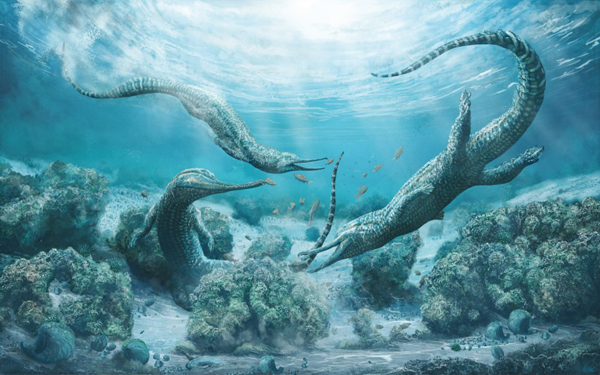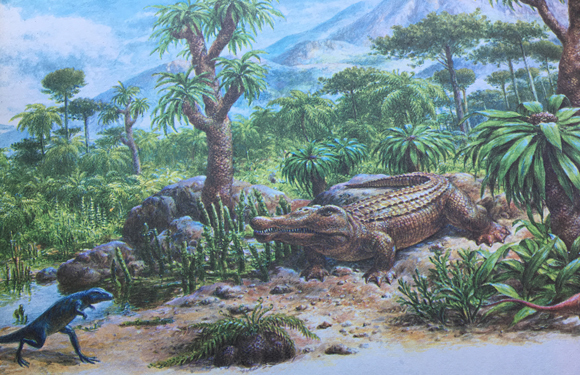New Triassic Marine Phytosaur Described
Austrian Phytosaur Fossils Point to Phytosaurs in Marine Environments
Look at most books that feature an illustration of the fauna of the Triassic and it is likely that squeezed into the colourful but so spurious illustration of early dinosaurs, beaked rhynchosaurs and cynodonts all going about their business but effectively ignoring each other, you will spot a phytosaur. Phytosaurs, the long-snouted, semi-aquatic carnivores that resembled crocodiles but were certainly not crocodilian, were widely distributed during the Triassic. However, very little evidence had emerged that linked these predators with marine ecosystems.
It had been thought phytosaurs were confirmed to freshwater or brackish environments. The publication of a new scientific paper, reporting on the discovery of the remains of at least four individuals from an ancient lagoon, represents the best evidence yet that these formidable predators also inhabited the sea.
Phytosaurs in Marine Ecosystems

Picture credit: Mark Witton (© 2019 The Linnean Society of London, Zoological Journal of the Linnean Society)
Mystriosuchus steinbergeri
Although the fossil remains were laid down in a coastal, lagoonal environment, these days, thanks to plate tectonics, the quarry site is two kilometres above sea level in a remote part of the Austrian Alps. The fossils were found in 1980 by Sepp Steinberger, a member of a local caving club. The species name (Mystriosuchus steinbergeri), was erected in his honour. One of the reasons cited for the amount of time it has taken to fully study these fossils is that despite the relative abundance of phytosaur fossils compared to other Triassic vertebrates, there are not that many vertebrate palaeontologists that specialise in studying the Phytosauria.
Phylogenetic analysis positions this newly described species as the sister taxon to a clade comprising Mystriosuchus planirostris and Mystriosuchus westphali. A study of the fossil bones indicates that the Austrian phytosaur specimens represent individuals that were at least eight years of age at the time of their death. The palaeoenvironmental data recovered suggests that these archosaurian reptiles were living in a marine lagoon. This provides strong evidence to support the idea that some phytosaurs may have adapted to living in saltwater as well as freshwater environments.
A Classic Triassic Diorama Depicting a Phytosaur

Picture credit: Rudolph Zallinger
How Did They Die?
Everything Dinosaur contacted one of the authors of the scientific paper, Richard Butler (School of Geography, Earth and Environmental Sciences, University of Birmingham), enquiring about the discovery of four individuals, all roughly the same age and the same size (approximately 4 metres in length), being found together.
Professor Butler commented:
“As to how these animals died and were buried together, your guess is as good as mine! It’s a puzzle, and I don’t have an answer. However, I think it’s very unlikely that they died together on land and were somehow washed out tens of kilometres and buried together. I think it’s more likely that they were living in the lagoon and died near to where they were buried. Interestingly, the fact that there are multiple individuals all of a similar size might suggest some social/group behaviour, although again it’s quite speculative.”
When asked to put into context the significance of this evidence supporting the idea of some members of the Phytosauria adapting to marine environments, Professor Butler explained that there have been a handful of occurrences of the species Mystriosuchus planirostris recorded in marine sediments in northern Italy, and the basal phytosaur Diandongosuchus was also found in a marine deposit.
Associated with Marine Deposits
These fossil discoveries have led to speculation that both these species were possibly marine animals. However, they’ve all been isolated specimens, and in the northern Italian sequences, for example, there is evidence to indicate that fully terrestrial animals had been washed into these marine deposits. So, in the case of these fossils, it is plausible that rather than being examples of marine phytosaurs, these are terrestrial phytosaurs that died on land and were washed out to sea.
The Austrian phytosaur material ascribed to Mystriosuchus steinbergeri might not be the first evidence found to support a marine environment hypothesis but it does probably represent the strongest evidence found to date.
The professor concluded that if he and his fellow authors are correct, then the phytosaurs represent yet another group of tetrapods that independently invaded marine environments.
The scientific paper: “Description and Phylogenetic Placement of a New Marine Species of Phytosaur (Archosauriformes: Phytosauria) from the Late Triassic of Austria” by Richard J Butler, Andrew S Jones, Eric Buffetaut, Gerhard W Mandl, Torsten M Scheyer and Ortwin Schultz published in the Zoological Journal of the Linnean Society.
Visit the Everything Dinosaur website: Everything Dinosaur.

